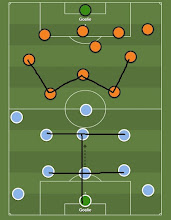Real Madrid has a history of making
big comeback wins in European competitions, although they are not as memorable
as Barcelona’s.
Real
Madrid’s continental campaign this season is currently in danger. Their
unexpected 3-0 defeat at Emirates Stadium against Arsenal in the first leg of
the UCL quarterfinals really stunned their fans around the world. They are
surely all hoping that Vinicius Jr and Co. will make an incredible comeback
despite having a three-goal deficit.
Los
Blancos too has a long history of comeback wins. Despite the fact that they
were not as well-known as their archrivals, especially in the Champions
League/European Cup, the reigning champion still has much potential to turn the
table in the second leg. Santiago Bernabéu does often bring magic necessary,
and such is what Real Madrid is expecting next week.
Throughout
history, Los Merengues have made several great comebacks since their first one
in the European Cup in 1960. At that time, Alfredo Di Stefano and Co. produced
a remarkable return at home with a 4-0 win after losing 3-2 to OGC Nice in the
quarterfinals. The Argentina star himself also netted one in their bounce back
alongside Pepillo, Paco Gento, and Ferenc Puskas, who scored one each.
Regarding
their current three-goal deficit, this is not the first time for the European
giants. They have been able to make a big comeback win in Europe with a similar
deficit or more not once or twice but three times on their home turf. Here are
those matches, which could inspire Los Blancos as well as still pose a real
threat to Arsenal despite having their advantage from the first leg.
Real
Madrid vs Derby County European Cup 1975/76 2nd round
Their
first big comeback took place in the 1975/76 season. In the second round of the
European Cup, Real Madrid were stunned by their 4-1 defeat to the English side,
Derby County. Their visit to English soil was met with devastating form, as
Dave Mackay’s men already had a two-goal lead in 15 minutes from Fred George’s
brace. Pirri was able to score a lifeline before David Nish restored their
advantage before the interval. Frederick George finally completed his hat trick
in the 78th minute.
However,
such a bitter tale became different in Bernabeu. The home side took control of
the game and already scored in the third minute from Roberto Martinez’s tap. He
added his tally early in the second half. Four minutes later, Carlos Santillana
headed home to give Los Blancos a three-goal lead. Nevertheless, the English
champion did not give up and managed to score through Fred George’s long-range
shot in the 62nd minute.
Derby’s
nightmare came in the 83rd minute as the referee gave a penalty for Real
Madrid. Pirri did not waste the opportunity to level the score on aggregate.
Such pushed the game to extra time. In these crucial minutes, Santillana netted
his second in the 99th minute, and their comeback was complete, 5-1 for the
home side.
Real
Madrid vs Anderlecht UEFA Cup 1984/85 3rd round
The
next comeback was even beyond imagination. It was in the mid-1980s when they
were building the new squad for their domestic glory. In the 1984/85 season,
they were playing in the UEFA Cup due to their failure to win a single La Liga
title from 1981 to 1985.
In
the third round, Luis Molowny’s side was already trailing 3-0 in the first leg
against Belgian powerhouse Anderlecht. Erwin Vanderbergh, Alex Czerniatynski
and Franc Vercauteren bagged the winning goals in Constant Van de Stock. They
were confident to keep the advantage while visiting Bernabeu.
Unfortunately,
such confidence suddenly faded as Real Madrid already notched up their first
goal in the third minute by Manuel Sanchis, plus another one in the 16th minute
from Emilio Butragueno. The Argentine forward, Jorge Valdano, even added the
third goal as the game was still at the half-hour mark. The Belgian side did
reduce their deficit as Frimann Hansen scored in the 34th minute. Yet, they
knew such would not last long. Five minutes later, Valdano bagged his brace,
and Real Madrid already clinched a 4-1 win before the interval.
In
the second half, Butragueno did not wait too long to add his tally in the 47th
minute. He even scored his hat trick five minutes later. It was already 6-1
before the game was even one hour. Such was surely a huge loss for Anderlecht,
as their three-goal advantage meant nothing once they touched down in the
Spanish capital.
Real
Madrid vs Gladbach UEFA Cup 1985/86 3rd round
In the following season, exactly in
the third round, Carlos Santillana and Co experienced a déjà vu, trailing in
the first leg with a big deficit and bouncing back in Bernabeu. Their victim
this time was Jupp Heynckes’ Gladbach.
It was a rather unbelievable comeback, as they had already suffered a 5-1 defeat on German soil. Gladbach
were convinced they would go through, as Madrid were never humiliated in such a
big loss. The reigning champion was set to face a heavy task at home in the
reverse fixture.
However, once again Real Madrid
delivered a stunning result. They already broke the deadlock in five minutes as
Jorge Valdano opened the scoring with his header. The Argentine World Cup
winner even doubled their lead with another header in the 17th minute. 2-0 for
Los Blancos in the first half.
In the second half, Madrid carried
on piling up pressure on Gladbach’s backline. It finally worked in the 73rd
minute as the skipper Santillana notched up a volley before netting his brace in
the 88th minute by taking advantage of the rebound. 4-0 for Los Merengues. It
remains their biggest comeback ever since in Europe.
Luis Molowny’s side went on to
defend the title as they crushed FC Köln in the final. It is their second
trophy in the UEFA’s third-tier competition in history.


Comments
Post a Comment